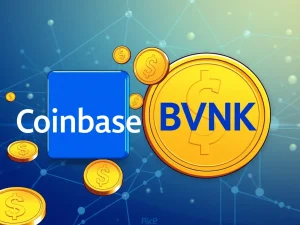Blockchain Jobs Surge: Regulation and Scalability Crucial to Close AI Hiring Gap

The tech world is buzzing with opportunity, but where does blockchain stand compared to the booming artificial intelligence sector when it comes to creating jobs? While the AI hiring gap currently favors AI, insights suggest that the blockchain industry is poised for substantial growth, potentially reaching over a million roles by 2030. This growth hinges on key factors like clearer Crypto regulation, improved Blockchain scalability, and deeper integration between AI and Blockchain.
Understanding the Blockchain Jobs Landscape
Compared to the massive software development sector (25 million jobs) and the rapidly expanding AI and machine learning field (over 1.5 million jobs), blockchain remains a smaller player in the tech industry, with roughly 300,000 global jobs. Data from job platforms indicates the sector added about 20,000 new positions in 2024.
Although blockchain job growth has shown a strong average compound annual growth rate (CAGR) of 45%, it still lags behind AI’s impressive 57% CAGR. Why the difference? According to Vugar Usi Zade, COO at Bitget exchange, the AI industry’s greater maturity and significantly larger venture capital investment are primary drivers. AI startups attracted over $100 billion in 2024 funding, leading to over a million vacancies globally. In contrast, blockchain companies saw around $5.4 billion in new funding and advertised fewer openings during the same period.
Bridging the AI Hiring Gap
Closing the AI hiring gap isn’t about competition, but about growth potential. While AI job listings have surged by 75% to 100% year-over-year, blockchain roles have grown in the 45% to 60% range. However, projections suggest that if blockchain can match AI’s scaling rate, it could exceed one million jobs by 2030.
Several factors are crucial for accelerating Blockchain jobs growth:
- Regulatory Clarity: Clear rules, like Europe’s MiCA, can instill confidence in firms, encouraging hiring. Similar clarity in major markets like the U.S. and Asia could unlock global headcount plans.
- Enterprise-Grade Performance: Improvements in Blockchain scalability are making the technology viable for corporate use. The Ethereum Dencun upgrade, significantly reducing Layer-2 fees, is a prime example, showing blockchains can handle substantial traffic efficiently.
While blockchain roles are set to increase, AI’s faster market integration means it will likely attract more talent in the near term, notes Jawad Ashraf, CEO of Vanar Chain. Blockchain is still focused on integrating with traditional finance and specific Web3 areas like gaming and tokenization, rather than widespread consumer markets, though this is expected to change.
The Powerful Synergy of AI and Blockchain
Instead of competing, AI and Blockchain are increasingly working together, creating new opportunities. This synergy is driving job growth in both fields. Combining these technologies can lead to sophisticated financial tools accessible to a wider audience, not just large institutions.
Companies are seeking professionals with expertise in both domains, recognizing the value of this cross-disciplinary knowledge. As financial and tech firms move integrated AI-blockchain solutions from pilot stages to core operations, steady job growth is anticipated.
Adi Ben-Ari, CEO at Applied Blockchain, highlights how AI’s probabilistic nature and the uncertainty it can introduce (like potential inaccuracies or fake content) increase the demand for blockchain and cryptographic technologies. Blockchain’s ability to provide certainty and secure sensitive data becomes vital as AI consumes more information. The real-world example of AI agents using cryptocurrency for autonomous transactions demonstrates this practical integration.
Future Outlook for Blockchain Jobs
The path to significant growth in Blockchain jobs is clear but depends on overcoming current hurdles. Achieving better Blockchain scalability and navigating the landscape of Crypto regulation are essential steps. The growing integration and synergy between AI and Blockchain further fuel this potential, suggesting that the current AI hiring gap could narrow as blockchain matures and its applications become more widespread.
While the journey involves challenges like securing adequate funding compared to AI, the fundamental utility of blockchain in providing trust, security, and transparency makes it a critical technology for the future, especially in an increasingly AI-driven world. The potential for blockchain to generate over a million jobs by 2030 is real, provided the industry continues to innovate, scale, and gain regulatory clarity.
Summary
The blockchain industry has substantial job growth potential, aiming to reach over 1 million roles by 2030. However, it currently lags behind the AI sector in hiring volume and funding. Key drivers for closing this AI hiring gap include establishing clear Crypto regulation, improving Blockchain scalability, and leveraging the synergy between AI and Blockchain. As these technologies integrate further and regulatory environments mature, the blockchain job market is set for a significant expansion, offering promising career paths for those with the right skills.







